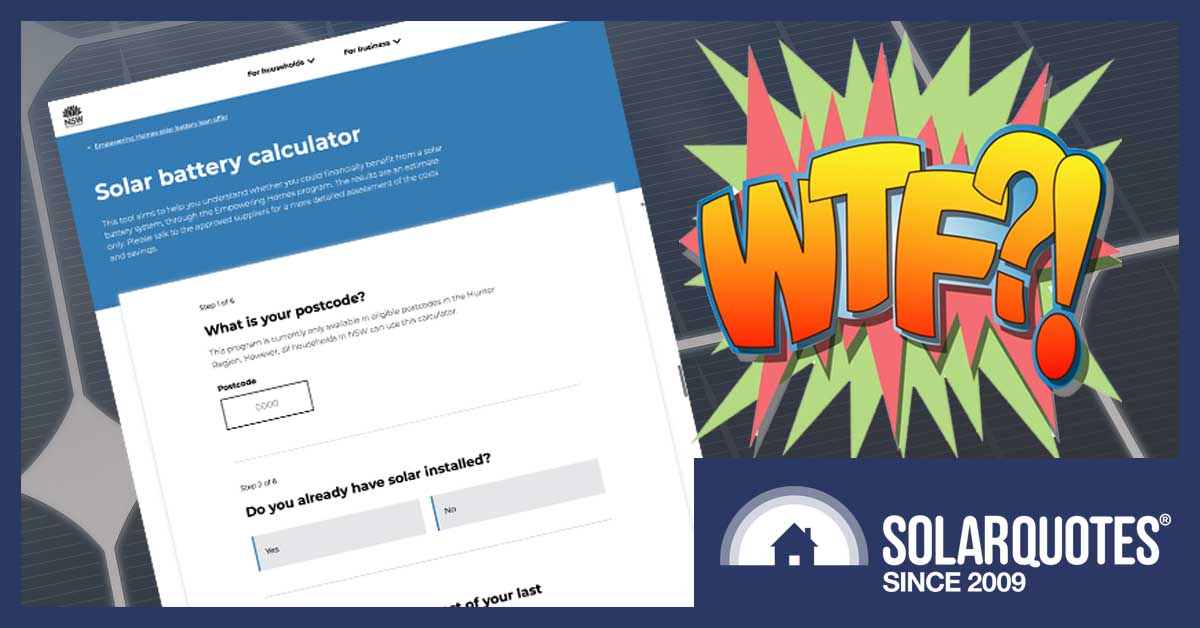
The new NSW solar & battery calculator is so misleading it’s not funny.
The NSW Government’s Solar Battery Calculator is up and running.
This would only be a good thing if it was up and running out the door, never to be seen again.
It had one job to do — inform NSW families if a home battery makes financial sense for them — and it fails miserably. Worse, it fails in exactly the wrong direction.
If its advice was too cautious it might put you off buying a battery that only just paid for itself. In which case you might miss out on dozens of dollars of electricity bill savings in a year.
Instead, it throws caution to the wind. The calculator declares that many NSW households will save with a home battery when the cold, hard reality is they’ll lose money. Families could lose thousands of dollars following the calculator’s advice.
Advice like this:
This is simply not true.
Right now a home battery system will only lose most NSW homes money. The only way you could correctly show this message to grid-connected homes in NSW is with unrealistically optimistic assumptions about the installed cost and/or the value of joining a Virtual Power Plant (VPP). The only reason the NSW Solar Battery Calculator says many NSW household are “likely to financially benefit from investing in a solar battery system” is because there is a profound and stupid mistake in how it does its calculations…
The NSW Solar Battery Calculator was designed as a companion to the NSW Government produced NSW Home Solar Battery Guide 2020 that I wrote about last week. Just like in the guide, the NSW Solar Battery Calculator makes the simple but serious mistake of blending the excellent payback of rooftop solar power with the lousy payback of home batteries. It assumes solar panels somehow magically improve the payback of a battery. Unfortunately, in real life, there is no such thing as magic.1
Happy Fun Batteries Are Fine
If the NSW Government had put out a guide saying:
“For most people, batteries don’t pay for themselves yet, but many people still want one because they are the wave of the future and can back up your home. This guide will help you buy batteries with your eyes wide open, and will never deceive you. Because we are the government. You can trust us.”
…that would be great.
Well, actually, it would be weird because it’s not the state government’s job to be a battery salesperson. And we all know you can’t trust the NSW government. But they do have an interest in making sure the electricity grid operates smoothly, so I can understand them wanting to encourage the installation of batteries, particularly ones that are VPP capable.2
But this isn’t what they are doing. They are instead going to cause real financial hardship for normal, everyday, NSW families by telling them they are likely to financially benefit from a battery that’s only likely to lose them money. The NSW Government should be ashamed of themselves.

While I don’t think home batteries will become outdated anytime soon, I have to admit it often doesn’t take long for what’s considered to be a wave of the future to end up looking like Western Australia’s 2.63 billion year old wave of the past. (Image: Fredrik Bülow)
A Losing Proposition In NSW
While NSW will provide interest-free loans for batteries in the right postcodes in the Hunter region, there is no big battery subsidy like in SA that could potentially make batteries pay. In addition, VPPs have yet to prove themselves. VPPs are also likely to be unprofitable right now, thanks to recent, large falls in wholesale electricity prices. This means anyone buying a home battery now in the hope of saving money is making a hell of an against-the-odds gamble.
It is easy to show home batteries cannot pay in NSW when used to store solar electricity for use at night. I used the SolarQuotes Retail Electricity Plan Comparison tool to get this edited list of standard tariff plans for Sydney:3
Without losses, the amount of money saved by storing 1 kilowatt-hour of solar electricity and using it at night is equal to:
The cost of grid-electricity per kWh minus the feed-in tariff per kWh.
This is because when you put your solar energy into a battery, you lose out on the feed-in tariff you would have received for exporting that electricity to the grid.
If we leave out the AGL plan at the top as an outlier, then assuming people sensibly choose electricity plans and don’t mistakenly or intentionally pick ones that make batteries look better, then each kilowatt-hour of stored electricity will save around 15 cents. But because the round trip efficiency of a battery system is typically 88% it will be closer to 13 cents. But to be kind to batteries I’ll round it up to 14 cents.
If a home battery with 10 kilowatt-hours of usable storage is bought and installed for $10,000 — which is less than the typical cost of one around that size — and it is fully cycled every day without suffering any deterioration in capacity, then it will save 10 x 14 cents per day: $1.40.
That’s $511 per year. If it has a 10-year warranty4 then when it ends it will only have saved $5,114 dollars if it’s assumed it magically doesn’t suffer any deterioration in capacity and it survives for 15 years, which seems unlikely, then it will only save $7,669.
To earn back its purchase cost it would have to operate for over 19.5 years — almost twice its warranty period. But it’s actually worse than that because if the household had instead put the $10,000 towards paying off their home loan, then with a 3% interest rate they would be nearly $18,000 better off after 19.5 years.
This means, if electricity prices remain more or less constant, then provided a household has a good alternative use for the money, the home battery system will never pay for itself. This is the case even if it never breaks down.5 We can make this calculation look better if we assume all the savings from the battery are invested, but this only reduces the problem and doesn’t solve it.
The Battery Won’t Be Fully Cycled Daily
No normal home is likely to use a battery’s full usable storage capacity each day. In practice, it will be significantly less because:
- There will be days when the household won’t use all the stored energy.
- There will be days, particularly in winter and when it’s cloudy when the battery will not be fully charged.
- Home batteries degrade over time.
This makes the payback time of batteries much worse than in the optimistic example I gave above. That is, they go from probably never paying for themselves to probably never paying for themselves even more.
Time-Of-Use Tariffs Don’t Help Enough
Having a time-of-use tariff can improve the payback time of batteries but not by enough to make them pay for normal households because:
- Time-of-use tariffs may be seasonal and so peak rates don’t apply for the whole year.
- Peak rates don’t apply on weekends6
- Normal households generally won’t be able to use all their stored energy during peak periods.
- The NSW peak period normally ends at 8:00 pm, so for half of summer it will end before the sun sets, which means at least some solar energy will still be produced through the peak period.
- Charging the battery with off-peak power (when surplus solar electricity production is expected to be low) may not be cost-effective due to the return not being worth the increased wear and tear on the battery.
If you want details, this article goes into more depth. But the mistake that is most commonly made is:
- Comparing savings of having solar power and a battery system on a time-of-use tariff to the savings from having just solar on a time-of-use tariff. The comparison should be to the best tariff available, which will often be a standard tariff for a home with just solar panels.
Looking at how helpful the NSW Government Solar Battery Calculator seems to think time-of-use tariffs are, I’m guessing it is over-optimistic about how much stored energy a typical home can use during peak periods. I’d also guess it’s not comparing the savings from having a battery and a time-of-use tariff to the best tariff available for a home without a battery.
VPPs Are Unproven
Virtual Power Plants have the potential to greatly improve the return from home batteries. Unfortunately, they are unproven as they don’t have a good track record of proven performance yet. There are also drawbacks to joining a VPP which include:
- Giving up full control of your battery.
- Increased battery wear and tear.
It’s very unclear how much VPPs can save. With a good VPP where the operator only keeps enough money to cover costs, the benefits to households could be large. But if a VPP operator decides to screw you over, then joining one may end up costing you money.
I don’t know how they worked this out, but the NSW Solar Battery Calculator estimates that joining a VPP is worth “up to $150 per year”:
It seems the NSW Government expects VPP operators to be assholes, keeping most of the benefit for themselves. If the benefit only comes to $150 a year at best, then it’s definitely not enough to make batteries pay for themselves. You might think the NSW Government should protect people from getting people ripped off by VPPs, but that’s not likely if they can’t even work out home batteries aren’t a good household investment yet.
If you are optimistic about VPPs making home batteries pay for themselves, then the logical time to get a battery is when that time arrives. Not now – in the hope that it will happen at some point in the future.
How Valued Is Backup Power?
Most, but not all, battery systems that are sold can provide backup power during blackouts. I haven’t tried to put a value on this because it will vary from person to person and location to location. Some places are more blackout-prone than others. But if the financial return from a battery is being maximized — or at least losses minimized — then there may be little or no usable energy in a battery when a blackout occurs. If some energy is always kept in reserve for when the grid goes down, this will reduce the return from using stored solar energy at night and from being part of a VPP.
People can, of course, decide for themselves how much battery backup is worth to them, but it’s clear it is not worth much to most households, as the large majority of NSW families have not purchased a home-integrated generator.
SolarQuotes Has A Solar & Battery Calculator
SolarQuotes has a Solar & Battery Calculator. Unlike the NSW government, we’ve put a lot of effort into ensuring the results it gives are accurate. And when I say “we” I mean my boss, Finn, has.
Only the simple version is available, with the advanced version being a work in progress, so we admit it’s not perfect. But it’s still the best on the internet by a longshot. It’s the only one I’m aware of that will break down the simple payback time into two parts, one for solar power and one for the battery. When the two are combined together it may make batteries look like a good idea, but being able to see the actual payback time of just the battery makes it obvious they are lousy when it comes to saving money.
It uses real-world data on electricity consumption and battery prices for its default figures, but you are free to enter your own prices if you wish.
Here’s a screenshot of our Solar & Battery calculator. Don’t worry if the type is too small to read. I just want you to see what it looks like so you won’t confuse it with anyone else’s:
Our Calculator Says NSW Battery Payback Stinks
I used the following graph in my previous article, which was on the NSW Solar Battery Calculator’s partner in crime, the NSW Home Solar Battery Guide 2020. But if you’re an optimist who views the world in a positive light, I’m happy to instead describe it as its partner in stupidity. The graph shows the simple payback time for a variety of battery systems given by our Solar & Battery Calculator. Simple payback is simply how many years it takes for electricity bills savings from the battery to equal its installation cost. No allowances are made for joining a VPP:
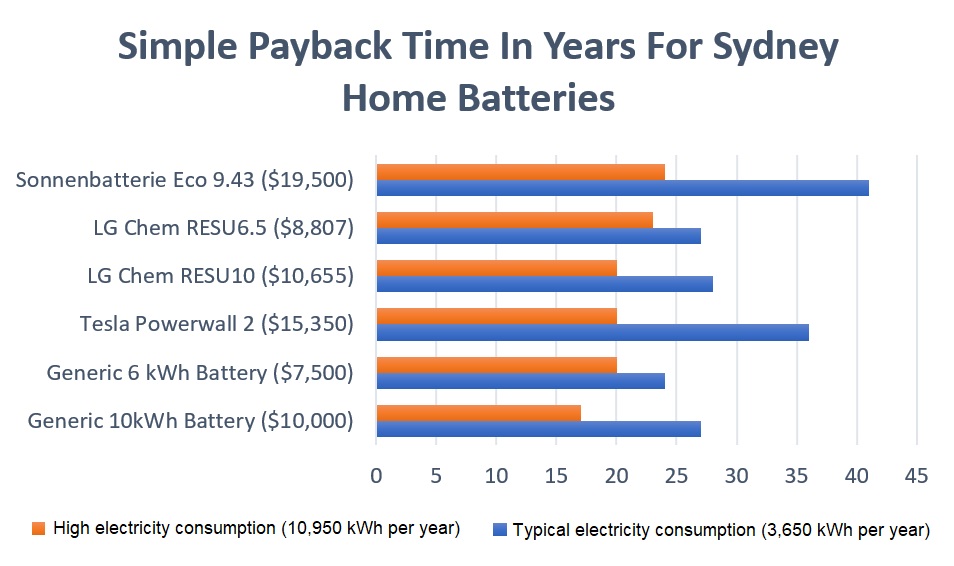
Simple payback time for battery systems in Sydney from our Solar & Battery Calculator, using default typical electricity consumption for the blue bars and 3 times typical household electricity consumption for the orange bars.
As you can see, none of them has a simple payback time less than 17 years with high electricity consumption or 24 with typical consumption. While this is lousy, I actually think the results it gives are too optimistic. Our calculator has a default assumption that electricity price inflation will be 3%. There is a slider so you can change the figure, but if you don’t touch it then it’s 3%. I think it’s more likely to be 0% and if I change it to that our calculator gives the following results:
This graph gives the number of years at the ends of the bars so you can easily see that, in what I think is a more realistic estimate, the simple payback time is never less than 22 years for high electricity consumption homes and never less than 34 years for a typical home.
Blended Payback Is The Battery Calculator’s Bad Egg
If your goal is to make a financial return on your investment, it’s clear that getting a home battery in NSW is not the way to go. Even if you’re optimistic about the long term returns from VPPs and your electricity consumption is high, installing one now in the hope it will pay for itself would be gambling and not a sound financial decision.
The reason why the NSW Solar Battery Calculator advises many NSW families to make a stupid gamble with their hard-earned money7 is because it makes the obvious and very stupid blunder of blending together the good payback of solar panels and the horrible payback of batteries; then pretending that makes sense.
As I explained in my last article, if you buy one hen that lays 20 eggs a month and another hen that lays zero eggs a month, just because you bought them at the same time doesn’t magically make them two hens that lay 10 eggs a month each.

Battery chickens do not lay golden eggs.
It Never Recommends Batteries If You Already Have Solar – Even If Your Electricity Bill Is 4 Million Dollars
Let me show you what the NSW Calculator looks like:
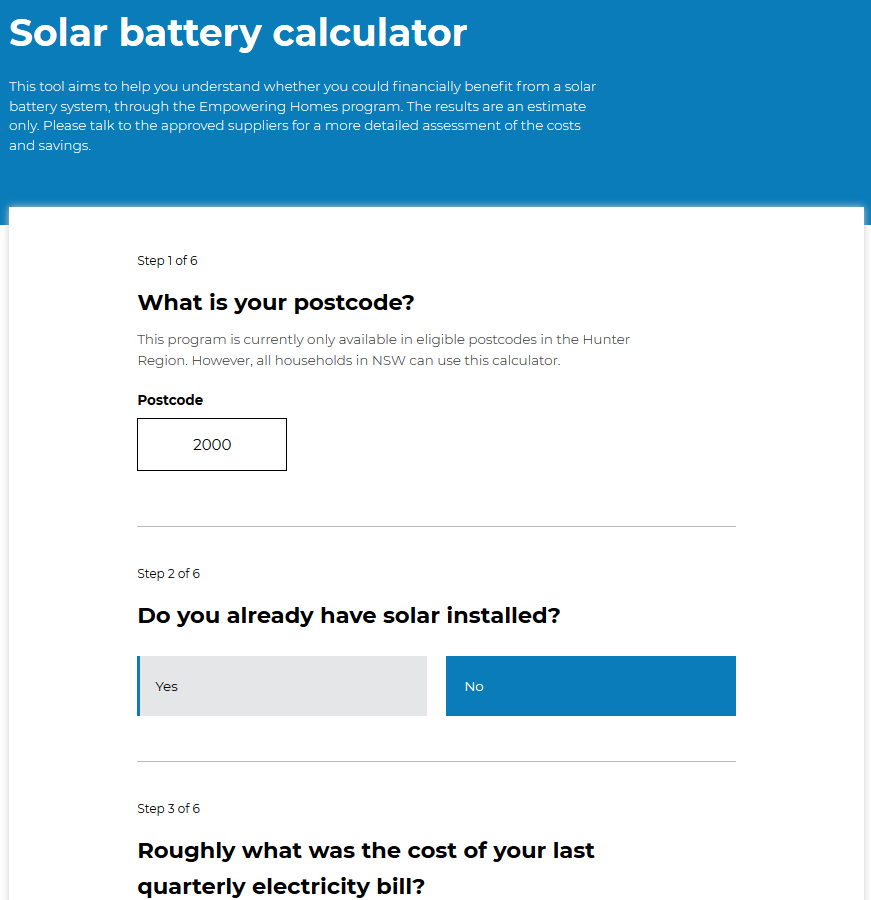
Wow, look at all that blue! Nice to see SolarQuotes has started a colour trend with battery calculators. I hope no one confuses them as a result…
If, in the following section, you tell it you already have solar panels…
Then it doesn’t matter what size you enter for your solar system or what you tell it your quarterly electricity bill is, it will never recommend getting batteries.
You can tell it that your electricity bill is $4 million dollars a year…
…and it still won’t recommend them. It will instead just give a wishy-washy message saying you may financially benefit:
It Recommends Batteries If You *Don’t* Have Solar – And Your Bill Is Over $291 per Quarter
But if you tell it you don’t have a solar power system, then — according to the other information you tell it — provided your quarterly electricity bill is at least $2918 it will recommend:
Why does the calculator tell us a $4 million a year electricity bill does not justify a battery but a $1,164 per year bill and no solar power does justify a battery? Because it stupidly thinks the good return from solar panels magically changes the negative return from the battery.
It Gives Horrible Sizing Recommendations
If I enter the following information:
- I don’t have solar panels
- My quarterly electricity bill is $400
- I use most of my electricity in the day and evening
- I’m interested in joining a Virtual Power Plant
- I have a time-of-use tariff
Then it gives the following size recommendations for the battery and solar systems:
This is horrible advice.
No matter what size the battery is there’s no realistic chance of it saving this household money, so the calculator is doing people a disservice by suggesting they get one at all. But apparently it’s not enough for it to recommend people get a battery that is only likely to lose them money, it feels the need to screw with them even more by recommending a solar power system that is far too small from the point of view of:
- Maximizing the return from their solar system.
- Providing enough solar energy generation to fully charge the battery reliably, increasing the financial losses from the battery even further.
Generally speaking, households with roofs that don’t suffer significant shading should be getting around 6.6 kilowatts of solar panels as a minimum. This is because the size that makes the most effective investment is often larger than this9 as the additional savings/electricity bill credits it provides makes the larger size worthwhile.
But when it comes to making a battery pay for itself — or at least not lose as much money — a large solar power system is vital. If you want to get a battery, either now or in the future, I strongly recommend getting a solar system larger than 6.6 kilowatts.10 This is because the larger the solar system, the more likely it is to produce enough surplus power to charge the battery in winter, on cloudy days, and when household daytime electricity consumption is high. With the 3-4 kilowatt solar system the NSW Solar Battery Calculator recommends, the battery will not fully charge every day and the financial losses from having one will be extreme.
Disaster Scenario
The NSW Solar Battery Calculator should be shut down immediately and reworked until the advice it gives is accurate. If the NSW Government is not willing to put in the work required, then the calculator should be shut down for good. This is because in its current state it will cause real economic harm to a significant number of families in NSW. I won’t say it will ruin lives because there is a lot of ruin in a life and most can handle a major setback or two, but it certainly has the potential to ruin finances. I’ll give a few examples of how this taxpayer-funded calculator can bring down financial ruin upon those it’s supposed to help.
Let’s say Bob is 24 and bought her11 first home 12 months ago. She knows from friends and family that solar power can be a great investment and decides to get advice from the NSW Solar Battery Calculator. She enters her quarterly electricity bill which averages $300, tells it she uses most of her electricity in the day and evening, thinks joining a VPP sounds fine, and enters that she has a time-of-use tariff. The NSW Government Solar Battery Calculator then advises her:
This is terrible advice because:
- The battery isn’t going to pay for itself, so it’s is bad financial advice from the start.
- She is missing out on the electricity bill savings she would have with a larger solar system.
- The small solar power system increases the financial losses from the battery as there often won’t produce enough surplus solar electricity to fully charge it.
- The small size of the battery means she will have to pay more per kilowatt-hour of capacity than for a larger system.
- The small size of the solar system means she will pay more per kilowatt of PV capacity.
- The kind of solar company that will happily sell her such a small, useless system are likely to be complete shonks that will rip her off. Most likely with a 0% interest ‘deal’.
It’s so bad it’s as though they are deliberately trying to sabotage the NSW home battery installation industry by creating a pissed off base of early buyers who will badmouth batteries for years to come.
Best Case Bob
As Bob’s electricity bill is only $300 a quarter, it means she only uses around 10 kilowatt-hours a day at most. If she uses half during the day and half at night and gets the 4 kilowatt-hour battery that’s right in the middle of the suggested range, it may look like she would be able to get a full cycle out of it each night, but because household electricity consumption varies there will often be times she won’t use all the available stored energy. Worse, if she gets a tiny 2.5 kilowatt solar system that is in the middle of the recommended range, in Sydney it will only produce an average of 6.7 kilowatt-hours a day in June. If half of that is consumed by the household during daylight hours then the average solar energy output in winter will not be enough to fully charge the battery. On top of this, almost every day that is overcast or heavily cloudy will be one where not enough surplus electricity is generated to fully charge the battery, no matter what time of year it is.
Because of her reasonably low overall electricity consumption, Bob won’t use much during peak periods; which will make it difficult for the battery to provide the majority of its stored energy when grid electricity is the most expensive. Also, because she only has a small battery, it’s power output will be low, which will further reduce its ability to meet household consumption during peak periods.
Because of these limitations, Bob may only use an average of 2 kilowatt-hours a day from her 4 kilowatt-hour battery. If each kilowatt-hour saves 20 cents on her electricity bills12 it will come to $146 over a year. This will decline as the battery capacity deteriorates and may average $140 a year over its lifespan if electricity prices remain constant.
With the following assumptions:
- It costs $1,500 per kilowatt-hour for a total installed cost $6,000 (she wasn’t ripped off).
- It lasts for 15 years, which is 50% longer than the 10 year maximum warranty period for most batteries.
- She receives an average of $150 a year from joining a VPP.
Over its lifespan it will provide her with $4,350 in savings which means she will be $1,650 worse off than if she hadn’t bought the battery. Actually, she’d be worse off than that, as she could have put the $6,000 towards her home loan or bought a much larger solar power system.
The NSW Government Needs To Fix This
The NSW Government has created a battery calculator that recommends people undertake a course of action that is only likely to cause them financial harm. So I have to wonder, why does the Government of NSW hate the people of NSW so much? Because if they don’t actually hate them, the only other explanation is the NSW Government is stupid. And does that seem likely to you?
But there are different degrees of stupidity. There’s being stupid enough to make a mistake. As we’re only human, we’re all capable of being that stupid at times. Then there is persisting in a mistake after it has been made clear how stupid you are being. That is true stupid or, if it harms people other than yourself, evil stupid. We’ll have to wait and see if the NSW Government fixes the calculator before we decide just what kind of stupid they are.
Footnotes
- But I’ll see what I can do to change that if you decide to spend a romantic evening with me, ladies… ↩
- Of course, they should also have an interest in energy efficiency, home energy management, “oversized” solar systems, improved transmission capability, synchronous condensers, and a slew of other things that can also help stabilize the grid. ↩
- I’m using Sydney because that’s where most people in NSW live. While there can be differences in electricity prices between regions in NSW, they are not large enough to make batteries pay. Note: Electricity retailers can supply misleading information on their plans, so it is necessary to check you will get what the information they provide suggests. ↩
- Home batteries normally have a maximum warranty of 10 years, but can be less than this if the battery is heavily used. Because batteries degrade with use and over time it’s not reasonable or wise to expect one that gets a lot of use to last well beyond its warranty period. ↩
- Even though you’d think a magic, entropy defying battery would actually be worth a considerable sum. ↩
- They appear to apply on public holidays in NSW but it’s always good to check. ↩
- Even if the money was easy earned, possibly from fact checking NSW Government guides, it still doesn’t mean it should be wasted on account of incompetent state government advice. ↩
- How high your quarterly bill needs to be before it recommends batteries ranges from $291 to $831 depending on other inputs you enter. ↩
- Most households are only able to export a maximum of 5 kilowatts of solar electricity, but it often makes financial sense to get a larger system that is export limited to 5 kilowatts. (Note this is not permitted in Western Australia.) ↩
- An exception can be if a household is export limited by the local DNSP to significantly less than 5 kilowatts. Western Australia is also an exception due to limitations on solar power system sizes. ↩
- Bob can be a girl’s name. ↩
- I’d expect the actual savings to be less than 20 cents per stored kilowatt-hour used, but I’m being optimistic here. ↩

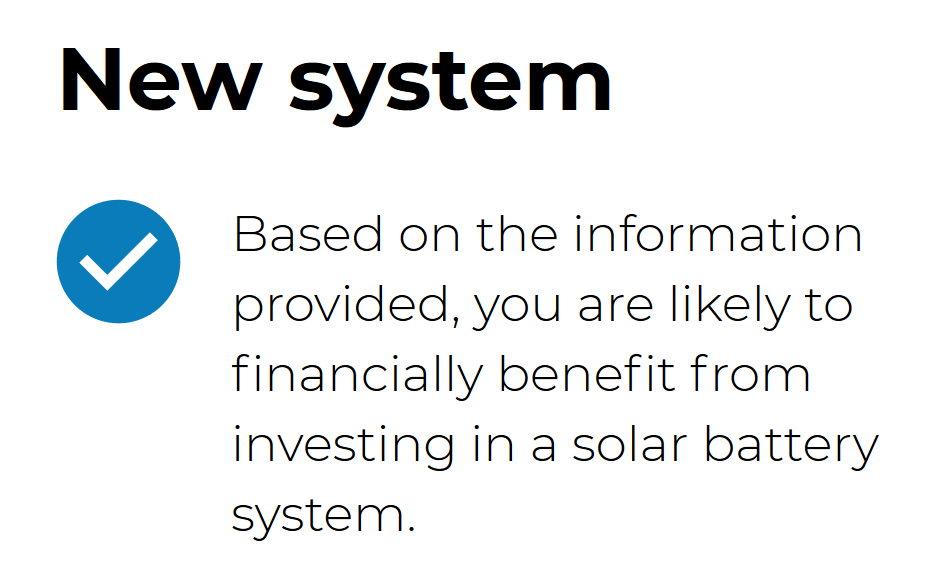
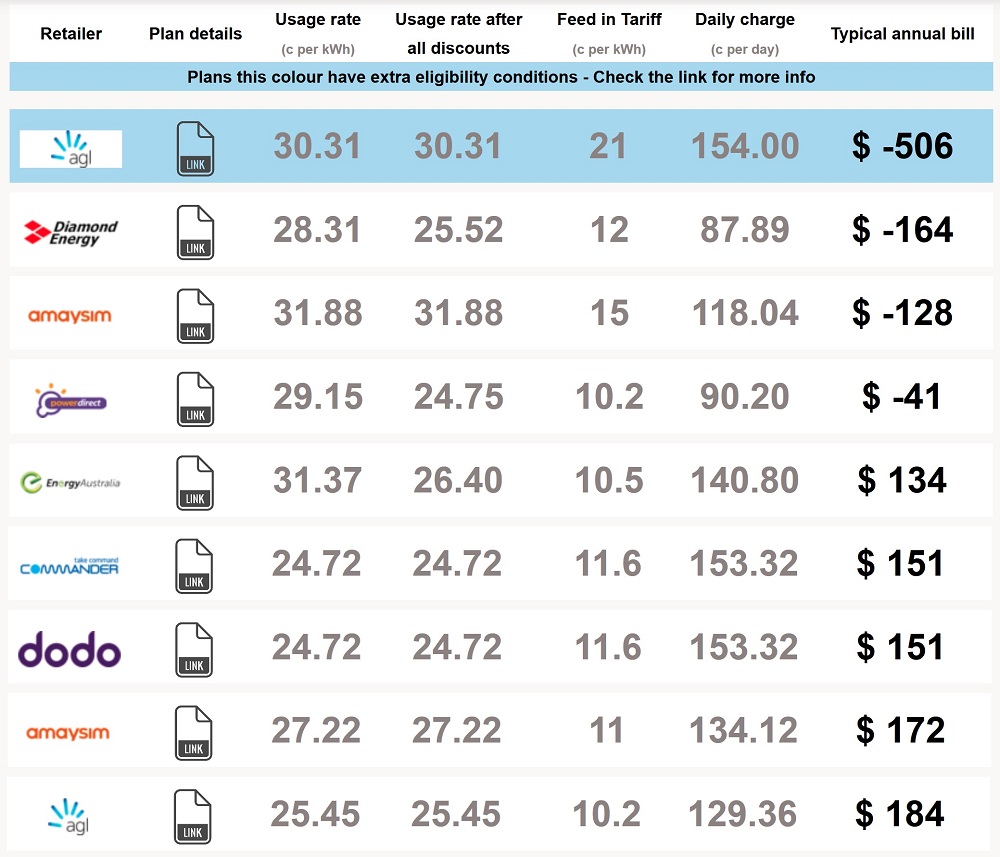

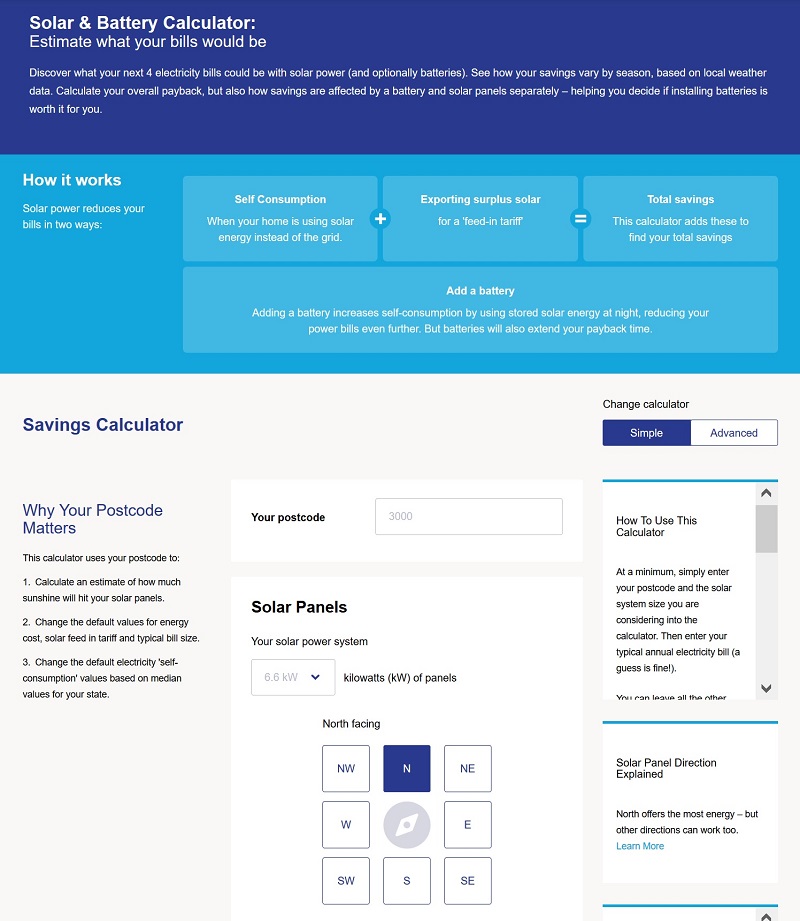
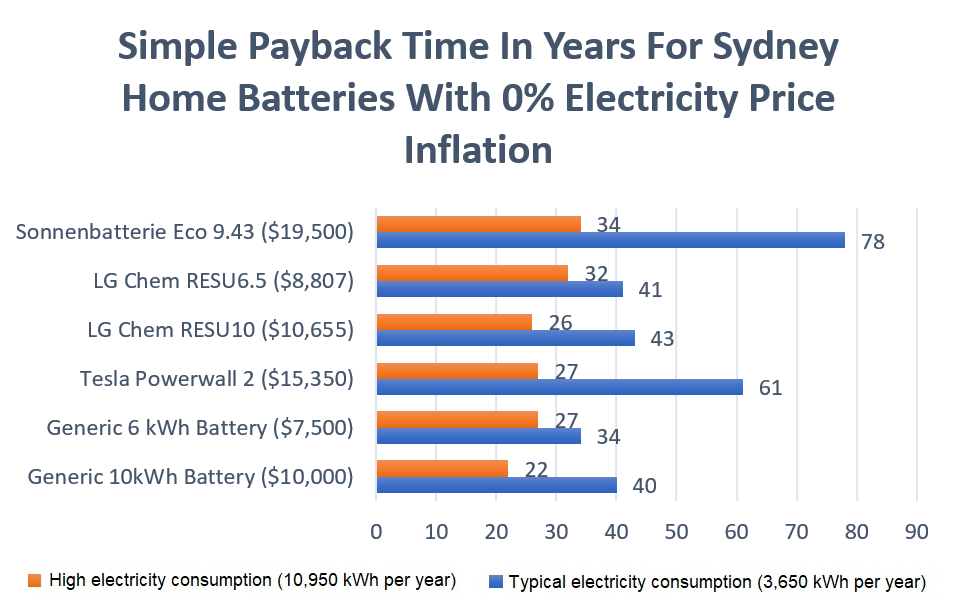
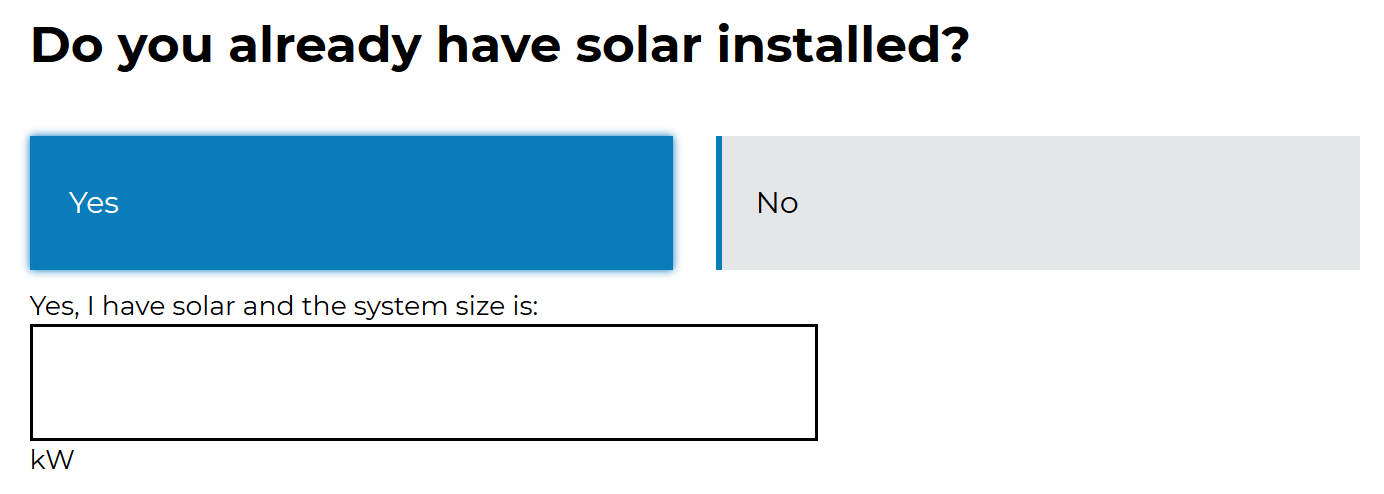
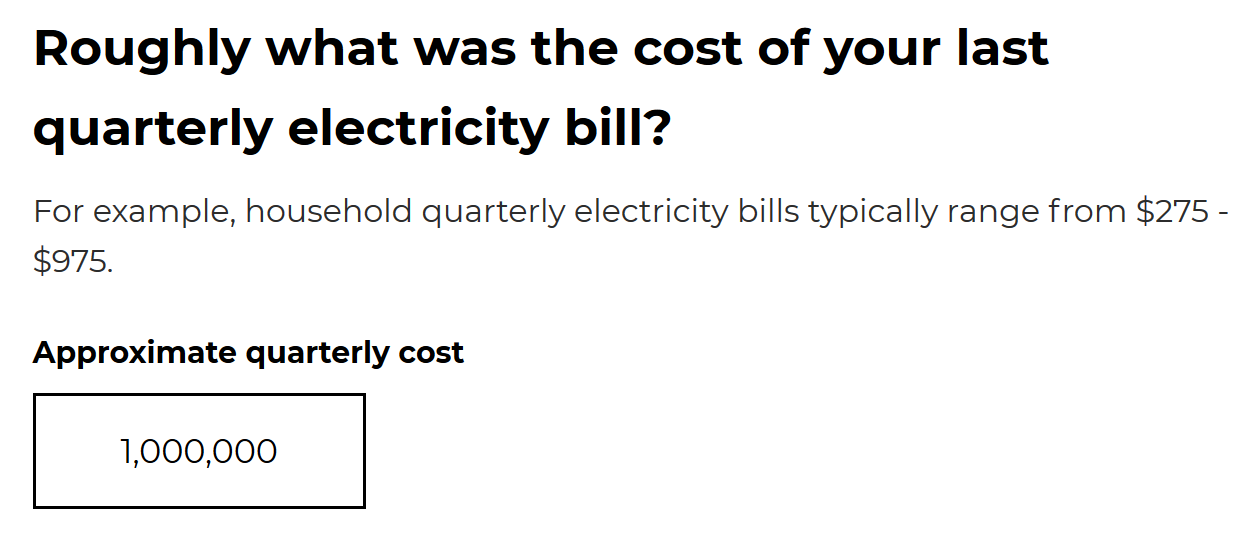
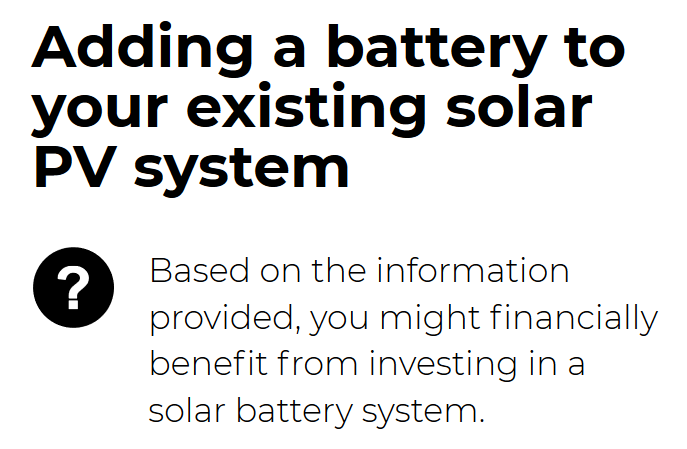
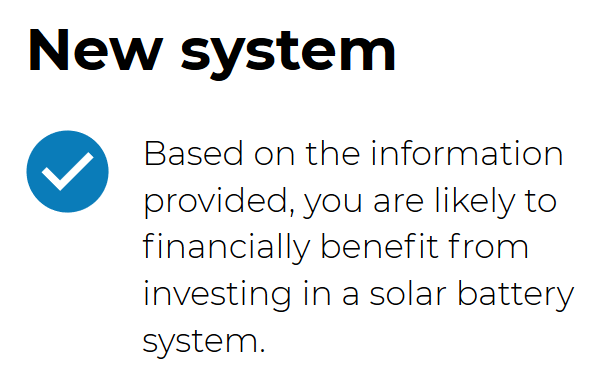
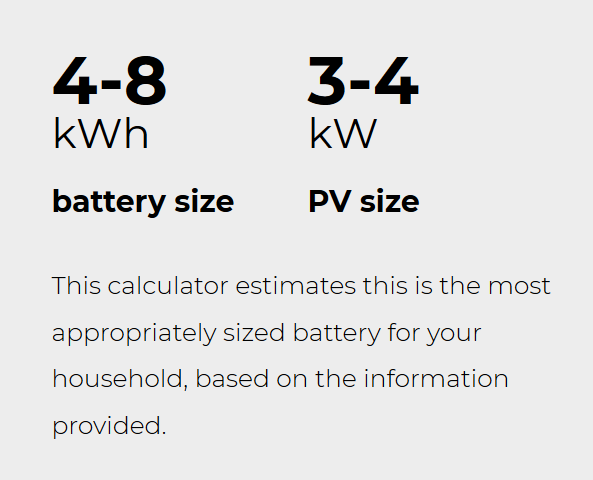
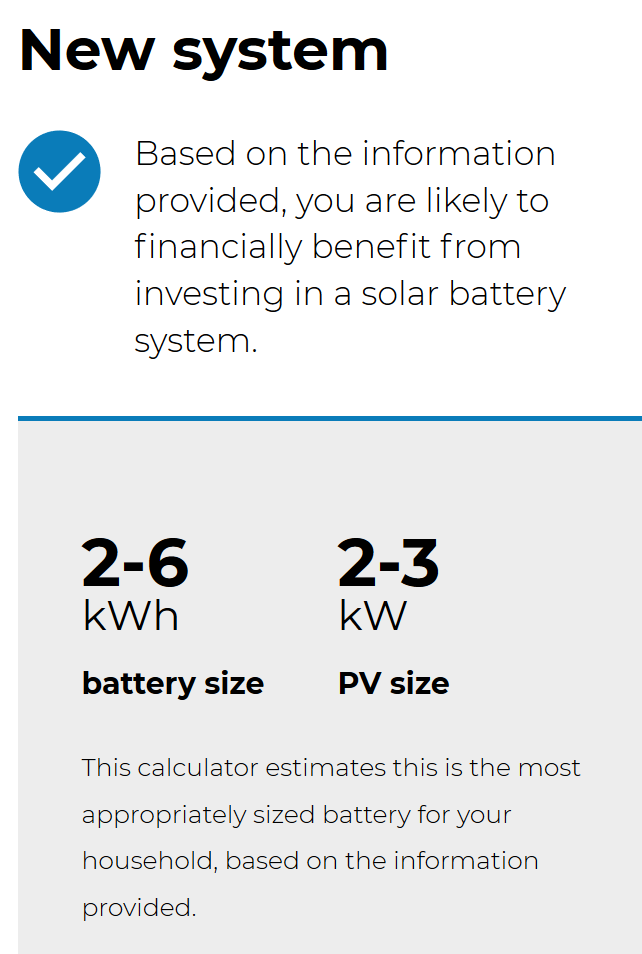

 RSS - Posts
RSS - Posts



Good article Ronald – very clear. Your “Bob” scenario is indeed a train-wreck for the NSW calculator.
Ronald – do you have a theory as to why state governments are actively supporting the installation of domestic batteries?
Yes, but none of them are good. They all depend on people being either devious, dumb, or just not good with other people’s money.
Some factors that go into the results stew we get could be:
1. The more private batteries that are installed the lower the cost of grid upgrades and the lower the cost of electricity.
2. Some generally want to be green without understanding that subsidizing batteries is a poor choice compared to other options at this time.
3. The wish to be associated with something that is new and popular.
4. Capture by unscrupulous business interests.
5. Design by committee where one or two bad eggs poison the whole process as no one wants to take responsibility and kick them out or shut them up.
6. Anti-renewable sentiment favoring batteries over actual clean generation.
If there was a small subsidy for VPP ready batteries, I could understand it from the point of view of ensuring most batteries installed were able to effectively support the grid. But beyond that I don’t really get it.
I see this entry on Quora. I don’t know where it was referring to.
One of our local utilities is installing them on customer’s houses for free. The utility gets to control the storage and can direct the inverter to deliver power to the grid at peak demand times when the utility may need to pay a dozen times the retail rate to buy peak power from the regional grid. That returned energy is “net metered” (at the retail rate) to reduce the customer’s electric bill. The utility makes a hefty profit on the returned power and pays nothing for the use of the customer’s roof. The utility gets to feed power into the grid exactly where it is needed without transmission losses. It’s a win-win.
Bodgy article Ronald, full of unsubstantiated assumptions. One eg of several:- “….question How Valued Is Backup Power?”.
Would any half-wit actually PAY A FEE for a grid-connection that was more than likely to go down…… and which you STILL get billed for ($600-odd?) whether you’re able use it or not? (Would you buy a car ~ or even a pushbike! ~ on that basis?)
The RELEVANT question would be: How much would you pay for back-up power FROM THE GRID if one day (or never, properly managed) your battery-bank went down?”
One way you can get as battery to pay for itself is if you are already at the maximum solar size for your house and want to install more capacity. In this case you only have one choice – somewhere to store the power that is not grid connected. Even then it’s hard to make the argument for commercially available home battery systems.
A battery doesn’t create more generation capacity John
A n even better way ~ proven by long and varied experience of someone whose opinion isn’t weighted by the money-motive ~ is to go stand-alone with the basic, PROVEN, components. KISS.
AGL just reduced its rate from $0.21 /kWhr to $0.105/kWhr as of July 1.
And just as bad as the NSW Gov are the unscrupulous companies stating massive savings by installing their battery systems ..all with the CEC Approved Retailer branding . Where is the ACCC when it goes pearshaped for consumers. Well done again thanks.
OMG who does the NSW Government employ to manufacture this rubbish advice, pity they don’t seem the advice of those like you who actually know what they are taking about.
Ron – why aren’t you or Finn putting this out on mainstream media rather than constantly preaching to the converted on this blog ? How many articles are you going to write telling us here that batteries aren’t economic yet ? You can’t tell me that some of the Media wouldn’t be interested in doing an anti NSW Gov’t news item ?
Personally I’ve heard the message and now I want to hear something else apart from “batteries don’t pay for themselves.” Move on and spread the message elsewhere.
Well put Adam. For the same reason atheists aren’t allowed to preach in churches: y’can’t have ANY brand of ‘believer’ (and collection-plate-filler) having their brainwashing being challenged.
The problem with going to the ‘the media’ is that some half-interested Jimmy Olsen would demand to know WHICH batteries might not pay for themselves ~ and on what basis…. and WHY other kinds of battery systems weren’t compared in terms of cost, efficiency. applicability etc.etc.
eg. Are there circumstances in which a Honda would be a better buy than a Roller ~ or vice-versa? And let’s not forget that these over-complicated massively-priced gee-whiz batteries have yet to PROVE THEMSELVES. (along with all the expensive prone-to-failure add-ons.) Finally the need to maintain a grid-connection invalidates almost ANY other consideration. Rather like getting around in a Honda with a RR in the boot ‘just in case’.
The Victorian battery rebate scheme is about to kick off again. It made no sense last time and probably still doesn’t but it is very hard to find any detail as to how the subsidy will be calculated.
In typical marketing nothing-speak the promo says “Installing a battery can help a typical household save up to $640 a year.” It doesn’t give a ‘down to’ figure.
If you have a decent solar system (over 5kW), I think saving $640 per year is a optimistic. As Bob points out: the basic calculation money saved is the difference between feed in tariff and buy tariff per kWh is correct.
Bob’s estimate of 14ct is to low though.
Also don’t forget GST. You will pay GST for every kWh you buy.
So if your feed in tariff is 12ct, cost per kWh is 31ct +3ct GST that means 22ct saved per kWh.
If you use 5kW per day from your battery in average per year, that adds up to 1.10 per day.
So yea that’s about 400$ per year. It will be hard to get your investment back. We probably would not use 5kW per day.
Unless electricity gets more expensive (Germany: 42 euro cent!!!), or batteries much cheaper, it’s not worth it atm. Maybe a larger battery and charging a car every night might change it in the future.